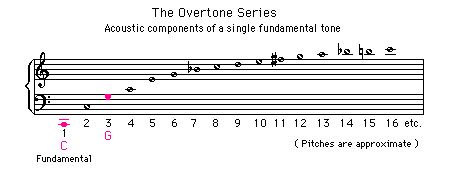The Overtone series
Each ("fundamental") tone constitutes not just one single pitch by itself, but is accompagnied by a series of higher pitches formed by progressively shorter divisions of the fundamental wavelength.
This produces the socalled "Overtone series".
The first "overtone" (also aptly called "partial": hase a wave length of half the fundamental's, the next one one third of the funadamental, followed by a quarter, and so on.
The number given to each member of this Overtones series corresponds with its fraction of the fundamental wavelength it represents.
In the Overtone series for the fundamental C, as shown below, partial number 2 is another C (one octave up). Partial number 3 is a G, a perfect 5th above that, and number 4 is yet another C, this time a perfect 4th above the G.
Audio 6.2
 Within this lower segment of the series the G is the first "foreign pitch" amongst the first three Cs. This has the effect that whenever a G (or G chord) needs to be "resolved" (move to a more stabel place) in a musical context, it tends to move to its closest related fundamental tone : C.
Within this lower segment of the series the G is the first "foreign pitch" amongst the first three Cs. This has the effect that whenever a G (or G chord) needs to be "resolved" (move to a more stabel place) in a musical context, it tends to move to its closest related fundamental tone : C.
Likewise the Overtone series for the fundamental tone of F, has a C as its third partial. This C when required to be resolved will move to its closest fundamental : F.
The Overtone series for the fundamental tone of Bb, has a F as its third partial. This F when required to be resolved will move to its closest fundamental : Bb.
The Circle of Fifths is therefore a continuous string of interlocking partial 3 to related fundamental tones which eventually connects up back with its starting point.
This inherent accoustic bond is extensively used as a tool in harmonies of Western music to move from one chord to the next and thus stringing together chord progressions.
|